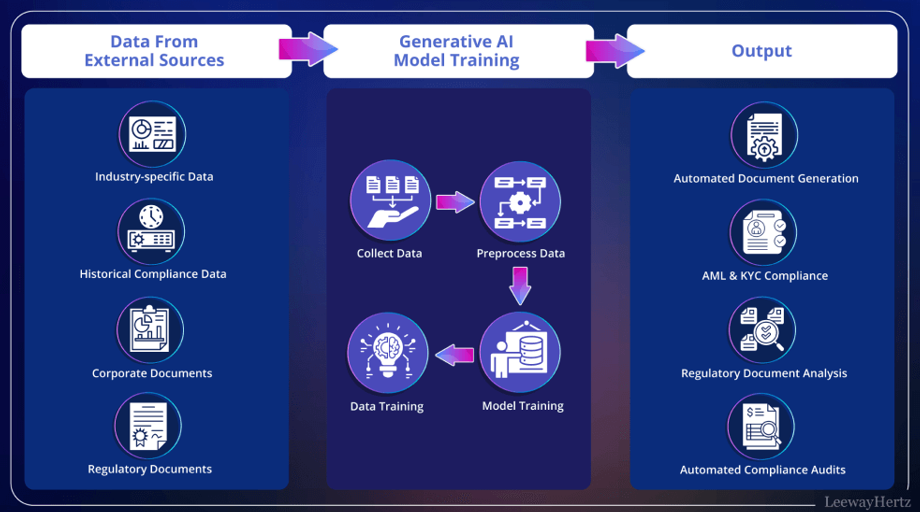
Transforming Compliance Workflows with Generative AI in 2025
Introduction: A New Era of Regulatory Complexity
In today’s fast-evolving regulatory environment, businesses across industries face mounting pressure to keep up with a complex web of compliance mandates. From financial reporting and data privacy to environmental and labor regulations, organizations are burdened with manual processes that are time-consuming, error-prone, and costly. Traditional compliance tools and legacy systems no longer suffice. To survive and scale, companies are now turning to Generative AI for regulatory compliance to automate, streamline, and strengthen their compliance operations.
Generative AI for regulatory compliance is revolutionizing how businesses interpret laws, monitor adherence, and adapt to change — all with a level of intelligence and flexibility that manual approaches simply can’t match.
The Role of Generative AI in Compliance Management
Why Traditional Compliance Systems Fall Short
Legacy systems depend heavily on predefined rules and human intervention. They often struggle to accommodate evolving regulations or handle unstructured data from varied sources such as contracts, emails, reports, and news bulletins. These limitations increase the risk of non-compliance, hefty fines, and reputational damage.
How Generative AI Enhances Compliance Capabilities
Generative AI can:
- Understand and process unstructured legal text using large language models (LLMs)
- Generate summaries, policy drafts, and action plans based on current regulatory frameworks
- Provide real-time insights into non-compliance risks
- Ensure consistent policy implementation across departments and geographies
Its ability to learn continuously from new data sources makes Generative AI ideal for keeping pace with ever-changing regulations.
See also: How Technology Is Revolutionizing Traditional Education
Key Use Cases Across Industries
Finance and Banking
In highly regulated sectors like banking, Generative AI helps analyze evolving global financial rules (like Basel III or Dodd-Frank), generates impact reports, and validates internal policies to ensure risk mitigation.
Healthcare and Life Sciences
With patient data privacy, FDA regulations, and clinical compliance in focus, AI enables automated audits, generates SOPs, and flags anomalies or potential violations in real time.
Energy and Utilities
Environmental, health, and safety (EHS) regulations are a key concern in the utilities sector. AI assists in understanding compliance obligations and ensuring that operational protocols align with regulatory expectations.
The Rise of AI-Powered Compliance Agents
From Generic Tools to Domain-Specific Agents
Generic AI platforms may struggle to meet niche regulatory needs. That’s where intelligent agents purpose-built for compliance come into play.
ZBrain’s Compliance Management Agent, for example, is specifically designed to address domain-specific compliance challenges. This solution acts as an always-on assistant that classifies documents, extracts rules, validates policies, and adapts to new mandates—all while offering explainability and traceability that regulators demand.
Key Features of Compliance AI Agents
- Automated policy validation against current regulations
- Real-time risk scoring and flagging of violations
- Workflow automation to route non-compliance issues to appropriate teams
- Integration with enterprise systems (e.g., document management, ERP, CRM)
Such agents go beyond alerts—they provide actionable intelligence and help enforce compliance across the organization.
Benefits of Using AI for Compliance
Improved Accuracy and Speed
Generative AI can analyze legal and policy documents at scale and with unmatched precision. It reduces human error and ensures faster turnaround in audits and regulatory assessments.
Scalability
Whether it’s a multinational with operations in 30 countries or a fast-scaling startup, AI allows compliance programs to scale efficiently without a proportional increase in headcount.
Cost Efficiency
By automating repetitive compliance tasks like document classification, reporting, and risk analysis, companies can save significant operational costs while focusing human expertise on high-value tasks.
Proactive Compliance
AI doesn’t just react to violations — it anticipates risks by constantly monitoring internal and external data, allowing companies to act before issues escalate.
Challenges and Considerations
Data Privacy and Security
Using AI in compliance must itself be compliant. Ensuring data security, especially when dealing with sensitive information, is non-negotiable.
Explainability and Transparency
Compliance officers and regulators need to understand how AI models arrive at conclusions. Platforms like ZBrain emphasize model explainability and audit logs for full transparency.
Human Oversight
AI should augment—not replace—human judgment. Domain experts are still essential to interpret nuanced legal issues, validate AI outputs, and provide strategic direction.
Future Outlook: AI as a Compliance Partner
As regulatory frameworks become more dynamic, Generative AI and specialized compliance agents will become indispensable partners to compliance teams. The organizations that adopt these tools early will not only improve operational efficiency but also gain a competitive edge in risk management, reputation, and agility.
Conclusion
The age of reactive, manual compliance is coming to an end. By leveraging Generative AI for regulatory compliance and intelligent agents like the Compliance Management Agent, businesses can automate the mundane, stay ahead of regulatory shifts, and focus on building trust with regulators, customers, and stakeholders alike.




